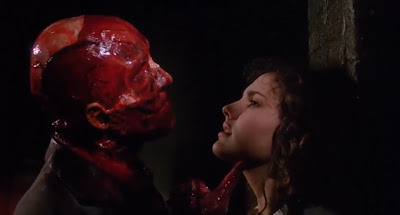 |
| Uncle Frank is back from the dead. This is not good news. |
Release Date: Sept. 10, 1987. Running Time: 93 minutes. Screenplay by: Clive Barker. Based on the novella, The Hellbound Heart, by Clive Barker. Directed by: Clive Barker. Produced by: Christopher Figg.
THE PLOT:
Larry (Andrew Robinson) and his second wife, Julia (Clare Higgins), have just moved into a house that is absolutely in America and is certainly, definitely not in north London. The house belonged to Larry's mother; but when they arrive, they can see that his no-good brother, Frank (Sean Chapman), had been squatting there, though he seems to be gone now.
Years earlier, Julia had an affair with Frank. She was drawn by his disregard for social niceties, such as not sleeping with your brother's wife, and by his insistence on pushing the limits of pleasure. That last was the trait that got Frank in trouble, after he procured a mystical puzzle box which opened a gateway to a very literal hell.
While moving their things into the house, Larry slices his hand open on an exposed nail. The blood from the wound drips into the floorboards of the very room where Frank solved the puzzle box. Somehow, those drops of his brother's blood are enough to revive Frank!
Julia discovers the husk of her lover, and Frank begs for her to get more blood to restore him. Soon, she is drawing men to the house, killing them so that he can become whole. But Frank knows that his escape will not go unnoticed for long. He needs more blood before his demonic jailers, the Cenobites, come looking for him - and his sights are set on Larry!
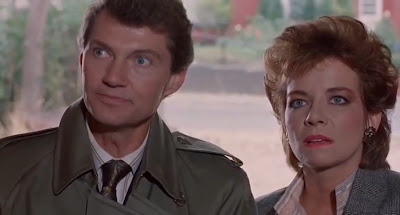 |
| The unhappy couple: Larry Cotton (Andrew Robinson) and his second wife, Julia (Clare Higgins). |
CHARACTERS:
Larry: Andrew Robinson was the movie's "name actor," a familiar face from both big screen and small whose presence would reassure audiences that this was a real movie. Behind-the-scenes material makes clear that Larry is meant to be someone defeated by life, a man who's given up in the face of disappointments. Unfortunately, little of this comes across. For the first hour, Larry's just sort of... there. Thankfully, the last part of the film allows Robinson some memorable moments, and he rises to that with manic energy - and, per the behind-the-scenes material, a few well-judged ad-libs. It's just too bad that, for most of the running time, poor Larry is more of a plot device than an actual character.
Julia: Frank talks about going "to the limits," but it's Julia who actually pushes what she had considered her limits. The Julia we first meet would almost certainly never consider murder, and she seems to come close to letting her first victim leave unharmed. Then the man turns aggressive, and you can practically see the moment Julia decide that she will go through with it after all. She's horrified by that first kill... but as she lets herself absorb what she's done, her expression changes, and we sense that a part of her enjoyed it. She sets new limits, lines that she insists she won't cross. In every case, she ends up going past that point, until by the end she's as much a monster as Frank is.
Kirsty: Larry's daughter from his first marriage, Kirsty (Ashley Laurence) resents Julia. There's no indication that she suspects her stepmother of anything nefarious. It's just the usual resentment of a young girl at seeing her mother replaced. She's mainly on the periphery for the first half, but she takes center stage in the final half hour. While the first hour is mostly presented through Julia's perspective, the final Act shifts to Kirsty, with her filling the '80s horror heroine/"final girl" role of being menaced by monsters, both human and otherwise.
Frank: Larry's hedonist brother, whose purchase of the puzzle box kicks off the story. Larry speaks of him with scorn, while Julia regards him with fascination. Though Sean Chapman, who plays the human Frank in flashbacks, has relatively little screen time, he makes a strong impression. He carries himself with the confidence of a man who takes what he wants with no heed for morality or consequences, and he and Clare Higgins have convincing screen chemistry that helps sell Julia's obsession. The present Frank - the monster - is played by Oliver Smith, with both actors overdubbed in the final product.
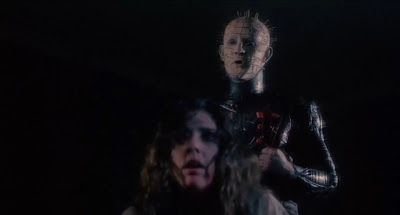 |
| Pinhead (Doug Bradley) menaces Kirsty (Ashley Laurence). |
DOUG BRADLEY AS PINHEAD... ER, "LEAD CENOBITE"
"We have such sights to show you..."
-Pinhead doesn't so much threaten as promise Kirsty an eternity of torment.
Doug Bradley's Pinhead is the monster of the Hellraiser series, with his visage gracing every poster and video cover. He was not originally envisioned as the primary monster, though. In this first film, he doesn't even have a name, being billed merely as "Lead Cenobite."
It's easy to see why he captured horror fans' attention. Bradley commands the screen. His deep voice, which seems to come up from some inner well, is far from book accurate; the "Hell Priest" in The Hellbound Heart was described as androgynous in both form and voice. But the voice perfectly fits both the film character and the splendid makeup job. Then there are Bradley's movements. The costume left him restricted in movement, which ends up being a benefit to the final product. When he moves, it's slowly. When he gestures, it's with deliberate care. Combined with the voice, this creates a sense of formality which only accentuates his power.
The character was referred to as the "Hell Priest" in both the novella and in the 2022 film, and some of his manner fits with that. Kirsty is able to save herself from the Cenobites by trading her freedom for Frank, the man who escaped them. When the female cenobite (Grace Kirby) indicates that she would prefer Kirsty, Pinhead shuts her down, phrasing it in quasi-religious terms as he insists on recovering Frank: "I want to hear him confess himself!"
All of this works together to make for a horror movie creation that, in his first appearance, earns his iconic status. Bradley, the costume and makeup design, and the writing all come together to create a figure that, in a mere eight minutes of screen time, ends up being the most memorable feature of a rather good movie.
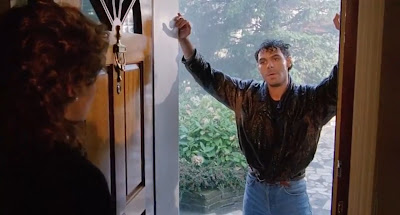 |
| Frank (Sean Chapman)'s first meeting with Julia... but the dubbing makes his dialogue seem artificial. |
THE SEMI-AMERICANIZATION:
A late production decision was taken by New World Pictures to redub several actors to "Americanize" it. This works well enough for Frank in his monster form, but it damages the flashbacks to human Frank and his affair with Julia. There's something aurally artificial about human Frank's lines. The words match the lip movements, but there's a processed quality that just sounds "off."
In the case of Kirsty's boyfriend, Steve (Robert Hines), there actually are a few lines that don't match lip movements. The dubbing also makes a hash of one exchange between Kirsty and Steve. She compares him to Julia, talking about how they're "uptight and frigid." Steve protests, "We're not all frigid," before pulling her in for an embrace. In its original context, an American girl would have been semi-jokingly comparing her British boyfriend to her British stepmother. With Steve Americanized, however, I have no idea who Steve's "we all" could reference. People with very '80s hair, I suppose - though that would include Kirsty as well.
I will allow that the redubbing contributes slightly to the atmosphere. Some of the settings are very British looking, while the mix of British and American accents clashes a bit with that. This oddly accents the sense of something otherworldly even before the demons show up.
 |
| Each of Julia's kills make Frank more human - and Julia less human... |
OTHER MUSINGS:
After being disappointed with two low-budget adaptations of a pair of his short stories (Rawhead Rex and Transmutations/Underworld), horror author Clive Barker was determined to direct his own work. Hellraiser became his first film as director. Despite its success, Barker would direct only two more feature films: Nightbreed and Lord of Illusions. I think this is a pity. All three movies have their faults, but all three also show a strong visual style and an ability to maintain atmosphere.
The movie's polish is boosted enormously by Christopher Young's score. The orchestral score emphasizes the sense of the otherworldly, making itself almost a musical counterpart to Pinhead's promise: "I have such sights to show you." As Frank is brought to life by Larry's blood, visualized through some creative and eye-catching visual effects, there's something triumphant about this resurrection. We don't yet know the details of what has happened to him, but we are musically thrust into his point of view as he exults in rebirth and his (as yet unknown to us) escape from his infernal prison.
The story itself is structured around points of view, the script shifting from one character to the next. A brief prologue with Frank kicks off the story and gives the audience an opening jolt. Then the film shifts primarily to Julia's viewpoint. There are a few cutaways to Kirsty, putting her into position to take over in the final Act, but until about the fifty-minute mark the story stays mainly with Julia. Then we cut to Kirsty's viewpoint with the climax, staying with her almost to the end, save for a closing sting.
The shifts help to keep the pace moving, but there is an inescapable problem when the focus shifts from Julia to Kirsty: Julia is a vastly more interesting character. For more than half the running time, we follow her as she descends from a merely unhappy wife into a mass murderer. She is horrified by Frank's monstrous appearance, but she doesn't remain horrified for long. She resists the idea of committing murder... but then she does it, and she even finds that a part of her enjoys the experience. Julia keeps drawing lines - but in every case, she ends up crossing those lines. Even at the end, we don't know where her final stopping point would be, or if she even has one.
By contrast, Kirsty is mostly a stock horror movie heroine. Ashley Laurence gives her a certain fierce physicality, particularly when she struggles bodily with Frank, and her overall performance is well above average for a low budget '80s horror flick. Even so, there's little depth to the character as written. Fortunately, the shift to her viewpoint coincides with the proper introduction of the Cenobites, and it's mainly down to them to keep up interest in the final stretch.
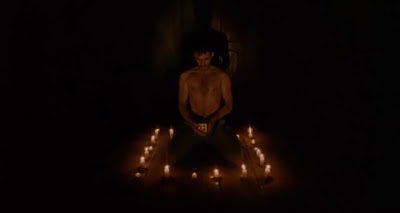 |
| Frank opens the box, kick-starting the plot. |
OVERALL:
The 1980s were the decade for horror classics: The Evil Dead, Re-Animator, John Carpenter's The Thing and Prince of Darkness, the Friday the 13th and Nightmare on Elm Street franchises, the Halloween sequels. Some of these were lousy, of course. But others were great, and it was a decade that offered an all-you-can-eat buffet of the macabre, with little sense that studios were afraid of pushing the boundaries of the "R" rating.
Hellraiser was among the last '80s horror franchises. Though the sequels would be variable in quality, the original still holds up within its genre. It succeeds as much through restraint as gore. After the prologue, the major moments of violence are held off, allowing for a slow build to the action. Performances are good, with Clare Higgins particularly strong.
Add in a well-structured screenplay and some creative special effects, and I'd have to say this movie is a fair bit better than I had expected. It's very much a product of its time, but it's still genuinely absorbing and unsettling. It may not transcend its genre - but it remains a highly effective example of that genre.
Overall Rating: 9/10.
Next Movie: Hellbound - Hellraiser II
Review Index
To receive new review updates, follow me:
On Twitter:
On Threads:
No comments:
Post a Comment